ARCHIVED: Chapter 8: Young people in Canada: their health and well-being – Bullying and Fighting
Bullying is a relationship problem - it is the assertion of interpersonal power through aggression (Pepler and Craig, 2000). Bullying has been defined as negative physical or verbal actions that have hostile intent, cause distress to victims, are repeated over time, and involve a power differential between bullies and their victims (Olweus, 1991; Pepler, Craig, and Connolly, 1995). Bullying is a subset of aggressive behaviours characterized by a power imbalance. With repeated bullying, the power relations between bullies and their victims become consolidated: bullies increase in power, and victims lose power. In such a relationship, young people who are being bullied become increasingly powerless to defend themselves. All aggressive behaviours are not bullying because there may or may not be a power imbalance, but all bullying involves aggressive behaviours.
Pepler and Craig (2000) have examined bullying from a developmental perspective and argue that this type of aggressive behaviour merits attention because it underlies many problems related to interpersonal violence in Canada. From this perspective, the lessons learned in bullying within peer relationships can be applied to other developmentally significant relationships. The use of power and aggression found in playground bullying is an indicator of future sexual harassment, dating aggression, workplace harassment, marital aggression, child abuse, and elder abuse (Pepler, Craig, Connolly, and Henderson, 2002). Thus, understanding and preventing bullying early may reduce such problems later on.
Concerns About Bullying
Researchers, educators, and parents have come to recognize that all young people involved in bullying are affected by it. Bullying most frequently occurs at school and under conditions where there is little adult supervision (Craig and Pepler, 1997). Youth who bully are at increased risk for perpetrating other forms of aggression, sexual harassment, and dating violence in adolescence (McMaster, Connolly, Pepler, and Craig, 2002; Pepler et al., 2002) as well as for engaging in illegal activities, such as delinquency and substance use (Pepler et al., 2002).
Victims of bullying also experience a range of problem behaviours, such as depression and anxiety; in extreme cases, suicide has occurred (Craig, 1998; Olweus, 1991). Some victimized youth become so frustrated and angry at the continuing abuse that they become aggressive and start to bully others (Goldbaum, Craig, Pepler, and Connolly, in press). Young people who bully others and are victimized by others (bully/victims) are at the most risk for both internalizing and externalizing behaviour problems (Craig, 1998). Even those who observe bullying may be affected (Pepler, Craig, Ziegler, and Charach, 1994), because they are often drawn into bullying and can play a major role in exacerbating or terminating bullying interactions (Hawkins, Pepler, and Craig, 2001; O'Connell, Pepler, and Craig, 1999).
Longitudinal research indicates that childhood bullying is associated with adult anti-social behaviour, such as criminality, as well as with limited opportunities to attain socially desired objectives (Farrington, 1993). Victimized youth are at risk for a variety of negative outcomes: they are more anxious and insecure (Olweus, 1991); have lower self-esteem (Craig, 1998); are lonely (Boulton and Underwood, 1992); are more likely to be rejected by their peers and are more depressed (Craig, 1998) than non-victimized young people. For elementary-aged youth, there is a stable propensity to be victimized. Using retrospective reports, Olweus (1978) found that adolescent boys who were victimized at age 13 were also victimized at age 16. Peers also suffer from bullying behaviour by feeling group pressure to join in the bullying. Merely observing bullying may lead to distress (El-Sheikh, Cummings, and Goetsch, 1989).
The price of involvement in bullying is high, generating lifelong costs in multiple systems, such as mental health, juvenile justice, special education, and social services. Interrupting this pattern of behaviour is a critical issue. The prevalence and seriousness of bullying and victimization compels researchers to examine this phenomena in order to improve the health of children and young people. Improving our current understanding can yield knowledge to provide direction for social policy and to design effective interventions that could eliminate or at least curtail this dilemma.
The Size of the Bullying Problem in Canada
Bullying is a problem that transcends national boundaries. Data from the 1998 HBSC indicate that Canadian students reported levels of bullying that fell in the mid-range for 11 countries (King, Boyce, and King, 1999), so Canadian rates for bullying and victimization were not among the highest but were by no means the lowest. This report examines the issue of bullying in three categories mutually exclusive of one another: being bullied, bullying others, and engaging in both of these behaviours.
Figure 8.1 presents the prevalence of students in the past couple of months in Grades 6 to 10 who were victimized by others but did not themselves bully others. There were several noteworthy findings. Overall, boys reported significantly more victimization than did girls (25 percent versus 21 percent). Second, the prevalence of victimization for boys peaked in Grade 10 (28 percent), while the peak for girls was in Grade 8 (24 percent). Third, a fairly consistent proportion of students, both boys and girls, reported being victimized about once or twice a term (from 8 to 16 percent). Finally, between 2 and 8 percent of students reported being victimized once a week or more. As previously discussed, these are the youth who require the most support in our schools and communities.
Figure 8.1
Students who were victimized but did not bully others (%)
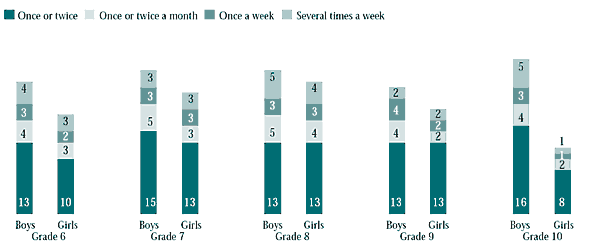
When asked about bullying others (e.g., perpetrating the bullying behaviours), approximately 23 percent of Canadian students from Grade 6 to 10 reported that they bullied others (Figure 8.2). Boys reported bullying others significantly more than did girls (25 percent versus 18 percent). For boys, the behaviour peaked in Grade 10, while it peaked for girls in Grades 7 and 8. As girls aged, a decrease in bullying behaviour was evident; this trend was not true for boys. Similar to the victimization scenario in Figure 8.1, the majority of students indicated that they engaged in the behaviour infrequently. However, a small minority of students (2 to 8 percent, depending on the grade) engaged in this form of aggressive behaviour regularly. It is this group of young people who likely require a more intensive intervention than those who engage in the behaviour infrequently. The proportion of students who reported bullying others was less than that of students who indicated that they were victimized. This suggests that young people who bully may be targeting their aggression against more than one individual.
Figure 8.2
Students who bullied others but were not victimized (%)
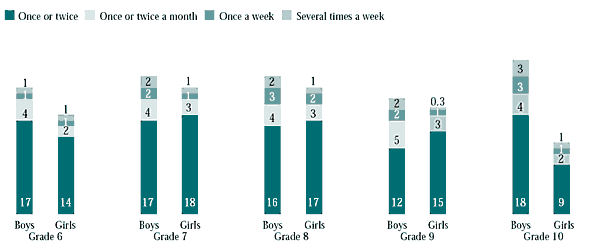
In contrast to other studies in the literature, a substantial number of students in the HBSC sample reported that they were both bullies and victims (Figure 8.3). Although other studies may have used a different threshold for examining the overlap between bullying and victimization, this proportion was still very high. Significantly more boys than girls across grades reported engaging in both types of behaviour (24 percent versus 19 percent). The prevalence was particularly high for boys in Grade 10 (28 percent); in contrast, the highest rate for girls (23 percent) was in Grade 8. As in the case of victimization, this behaviour for girls tended to decrease with age, but did not for boys. Young people who are bully/victims are at the most risk for problems, as they report problems associated with both behaviours (Craig, 1998). This group of youth and the high proportion they represent should be of particular concern.
Figure 8.3
Students who were both bullies and victims (%)
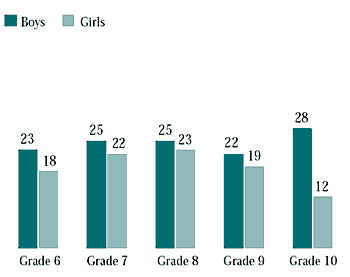
How Young People Bully Others
Bullying took many forms, with the most common being teasing, excluding, or spreading lies about the victim. The HBSC survey examined the types of aggression perpetrated against students who reported being bullied. Figures 8.4 and 8.5 illustrate that significantly more girls than boys across grades reported being teased (79 percent versus 67 percent) and having rumours spread about them (72 percent and 63 percent, respectively). The prevalence of these behaviours did not decrease substantially with age. In contrast, Figure 8.6 shows that significantly more boys (about 45 percent) reported physical victimization, compared with girls (about 21 percent). For both boys and girls, the reported rates of physical victimization decreased with age; this trend was consistent with the literature on aggressive behaviour (Moffitt, Caspi, Rutter, and Silva, 2001).
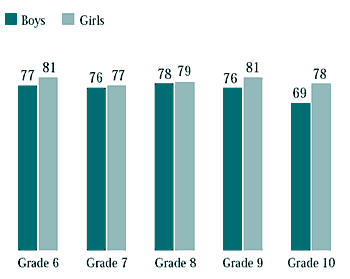
Figure 8.5
Bullied students who said they were excluded or had rumours or lies spread about them (%)
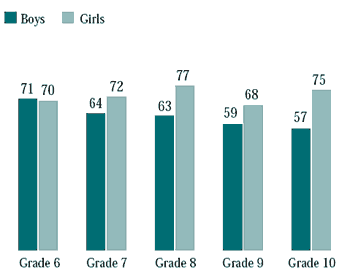
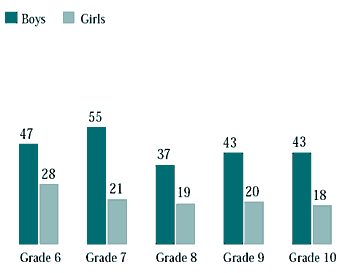
Because bullying refers to behaviours that combine power and aggression and involve understanding others' vulnerabilities, the HBSC survey asked about sexual harassment and bullying based on race and religion. Reports of sexual harassment increased with age for girls, but not for boys; and on average, about 43 percent of students reported experiencing sexual harassment (Figure 8.7). However, boys were more likely than girls were to report being bullied because of their race (Figure 8.8). Finally, on average, about 14 percent of students stated that they were bullied because of their religion (Figure 8.9). Bullying because of race and religion occurred less frequently than did all the other types of bullying.
Figure 8.7
Bullied students who said they were victimized by sexual jokes, comments, or gestures (%)
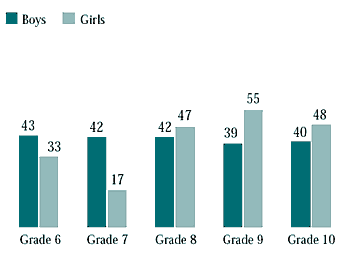
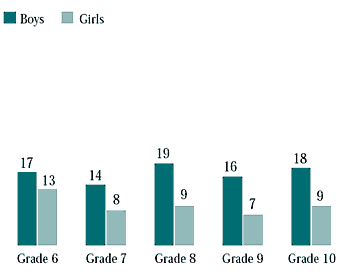
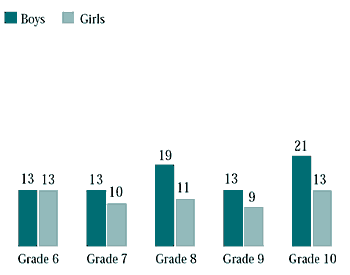
The HBSC survey also asked students who said they bullied how they victimized others (Figures 8.10 to 8.15). In general, they reported engaging in lower rates of teasing, spreading rumours, physical aggression, sexual harassment, and racial or religious harassment than were reported experienced by victims. The gender differences for those who reported how they bullied others and for those who reported how they were victimized were similar, with the exception of sexual harassment. In the case of the victims, boys and girls reported relatively similar levels of sexual harassment, with levels for girls increasing with their age. In contrast, for bullies, boys consistently reported perpetrating more sexual harassment than did girls, and this behaviour increased with age. The difference in the reported rates of specific types of aggression between victims and bullies suggests that they interpreted and experienced behaviours differently. For example, the behaviour that victims experience as aggression may not be what bullies define as aggression. Hence, an educational component in intervention programs needs to specifically address the different forms of aggression and their harmful consequences.
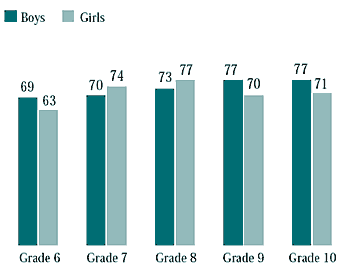
Figure 8.11
Bullies who said they victimized others by excluding them or spreading rumors or lies about them (%)
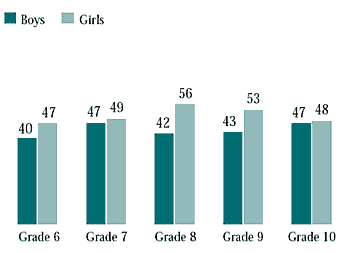
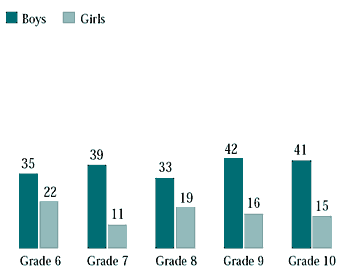
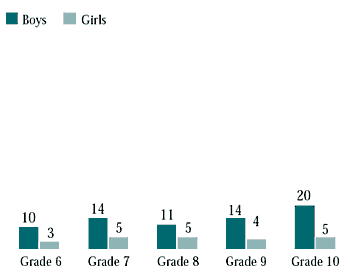

Figure 8.15
Bullies who said they victimized others by making sexual jokes, comments, or gestures (%)

Fighting Behaviour
Although physical fighting behaviour may or may not be defined as bullying (depending on whether there is a power imbalance), it is an extreme form of aggression and merits attention. Figure 8.16 shows the reported frequency that students in the HBSC sample were involved in physical fights. Several observations can be made from these data. First, in all grades, more boys than girls reported engaging in fighting, and boys reported being involved in fights more often than did girls. Significantly more boys than girls reported physical fighting behaviour: 47 percent of boys versus 24 percent of girls. Second, for boys, fighting behaviour decreased with age; however, the rates remained unchanged for girls. Third, when asked with whom they fought, a high proportion of boys and girls indicated that they fought with friends or acquaintances. In addition, girls said that they were most likely to fight with a brother or a sister (Table 8.1). It may be that girls are more likely to be aggressive within the confines of intimate family relationships or that it is more acceptable to fight within these relationships. Boys also stated that they fought with their siblings, but this behaviour decreased with age. Older students were more likely to fight with strangers, people whose history and tendency to be aggressive were unknown. In doing so, they could put themselves at substantial risk for serious injury or harm. Physical fighting with adult family members or a romantic partner occurred relatively infrequently for both boys and girls.
Figure 8.16
Frequency with which students were in a physical fight in the past 12 months (%)
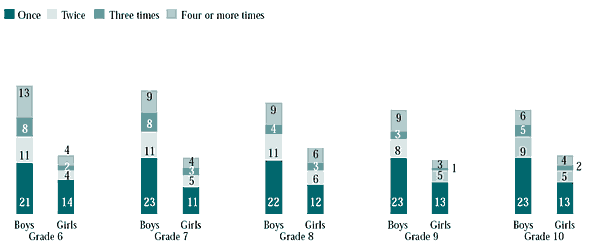
Major Findings:
- Over 20 percent of students reported being both bullies and victims of bullying.
- Sexual harassment reported by girls peaked at Grade 9.
- Physical bullying reported by boys peaked at Grade 7.
- Sexual harassment reported by girls increased with age.
- More boys than girls experienced harassment because of their race, ethnicity, and religion.
- Students did not report being bullies as often as victims experienced bullying.
- More boys reported physical fighting, and frequent fighting, than did girls.
- Physical fighting decreased with age in boys but stayed constant in girls.
- Boys most often fought with friends or acquaintances, while girls were equally likely to fight with their sibling
Page details
- Date modified: